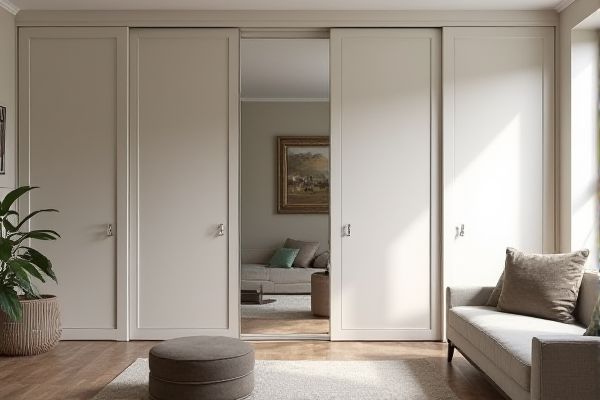
Sliding wardrobe doors save space by gliding smoothly along tracks, making them ideal for smaller rooms or tight layouts, while hinged doors swing open, providing full access to the interior but requiring clearance space. Discover which door style best suits your needs and enhances your room's functionality and design by exploring the rest of this article.
Table of Comparison
| Feature | Sliding Wardrobe Doors | Hinged Wardrobe Doors |
|---|---|---|
| Space Efficiency | Ideal for small rooms; doors slide along tracks without needing extra space | Require clearance to open outward; less space-efficient |
| Accessibility | Only one section visible at a time due to sliding mechanism | Full access to entire wardrobe interior when doors are open |
| Installation Complexity | Requires precise track placement and alignment | Simple installation with standard hinges |
| Maintenance | Track cleaning and roller maintenance needed | Hinge lubrication and alignment |
| Aesthetic Options | Modern look; customizable with mirrors, glass, or panels | Traditional appearance; various wood and panel styles available |
| Durability | Rollers and tracks prone to wear; mid-level durability | Sturdy hinges; generally longer-lasting |
| Cost | Generally higher due to hardware complexity | Typically more affordable |
Overview of Sliding vs Hinged Wardrobe Doors
Sliding wardrobe doors save space by gliding along tracks, making them ideal for small rooms or tight spaces, while hinged doors require clear floor space to open outward. Sliding doors often feature large mirrored panels or sleek glass, enhancing room brightness and modern aesthetics, whereas hinged doors typically offer easier access to the entire wardrobe interior without obstruction. Maintenance for sliding doors involves keeping tracks clean to ensure smooth operation, whereas hinged doors may need periodic hinge tightening or lubrication to prevent squeaking.
Space Efficiency: Sliding vs Hinged Doors
Sliding wardrobe doors maximize space efficiency by gliding along tracks without requiring extra clearance, ideal for compact rooms or narrow walkways. Hinged doors need ample space to swing open, which can limit furniture placement and restrict room flow. Choosing sliding doors can enhance your room's usability by saving valuable floor area typically taken up by door arcs.
Aesthetics and Design Flexibility
Sliding wardrobe doors offer sleek, modern aesthetics that save space, making them ideal for minimalist and contemporary interiors. Hinged doors provide classic design flexibility, allowing full wardrobe access and customization with panel styles, colors, and hardware. Both options enhance room decor, but sliding doors effectively maximize floor space while hinged doors enable more intricate design expressions.
Ease of Access and Functionality
Sliding wardrobe doors maximize ease of access in tight spaces by gliding smoothly along tracks, eliminating the need for clearance required by hinged doors. Hinged doors offer full and unobstructed entry to the entire wardrobe interior at once, ideal for organizing and retrieving items quickly. Functionality-wise, sliding doors optimize room layout efficiency, while hinged doors provide more versatile access options depending on the wardrobe design.
Installation Complexity and Requirements
Sliding wardrobe doors require precise track alignment and secure mounting to ensure smooth operation, often demanding more technical skill during installation. Hinged doors are generally easier to install with standard hinges and straightforward measurements but need sufficient clearance space to open fully. Both types benefit from professional installation to guarantee optimal functionality and durability.
Durability and Maintenance Factors
Sliding wardrobe doors feature a track system that requires regular cleaning and lubrication to prevent sticking and ensure smooth operation, while hinged doors have simpler mechanisms with durable hinges that often need less frequent maintenance. You should consider that sliding doors are more prone to misalignment or debris buildup which can affect durability, whereas hinged doors typically offer greater longevity with fewer mechanical issues. Choosing the right door type depends on your maintenance preferences and the durability requirements of your wardrobe space.
Cost Comparison: Sliding vs Hinged Doors
Sliding wardrobe doors typically cost more upfront than hinged doors due to their complex track systems and custom-fit requirements, but they save space in smaller rooms, potentially reducing renovation expenses. Hinged doors usually have lower initial costs and easier installation but require clearance space for opening, which can limit room layout options and incur additional costs for room adjustments. Your choice depends on balancing immediate budget constraints with long-term spatial efficiency and design needs.
Storage Optimization and Interior Layout
Sliding wardrobe doors maximize storage optimization by eliminating the swing space required for hinged doors, allowing for more usable floor area and storage capacity within smaller rooms. Their flush design supports streamlined interior layouts, enabling furniture placement closer to the wardrobe without obstruction. Hinged doors demand clear space to open fully, limiting room arrangement options and reducing efficiency in compact interiors.
Suitability for Different Room Sizes
Sliding wardrobe doors are ideal for small or narrow rooms since they do not require extra space to open, making them highly space-efficient. Hinged doors need enough clearance to swing open fully, which can limit furniture placement and reduce usable floor area in compact rooms. Your choice depends on room size and layout, with sliding doors offering a sleek solution for maximizing space in tight areas.
Final Verdict: Choosing the Right Wardrobe Door
Sliding wardrobe doors maximize space efficiency and offer a sleek, modern aesthetic, ideal for small rooms and contemporary interiors. Hinged doors provide full access to the wardrobe interior, enabling easier organization and maintenance, suitable for larger spaces and traditional designs. Selecting the right wardrobe door depends on room size, design preference, and functionality requirements to optimize both space and usability.
 homyna.com
homyna.com